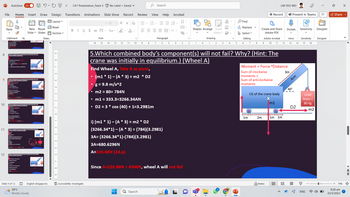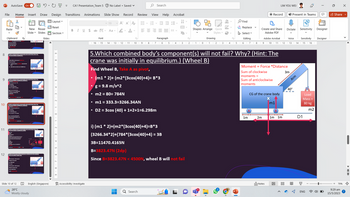The crane body (with arm) is 333.3 kg and the red block is 80kg. The maximum force that the wheels (A & B) and the arm can take is 4500N and 2000N respectively. The combined crane body moves at 10 km/h and 0° while the arm moves 0.1 m/s and 40°
Can tutor explain step by step and also the explanation such as like why use that formula and why is it this cannot.
below is the questions need to answer by using the diagram
1)Calculate the velocity of the arm, observed by a stationary person on the ground.
2)Draw the FBD of the combined body (crane body, arm and load).
3)Is the combined body stable? Why?
4)Calculate the moment of the following, about wheel A,
i) combined crane body
ii) load mass
5)Which combined body’s component(s) will not fail? Why? (Hint: The crane was initially in equilibrium.)
6)What are the various limits (maximum or minimum) for the combined body to be stable? Explain why.

Step by step
Solved in 3 steps with 8 images

For question 5, this is my way of calculate wheel A and B to find is the component will fail
is this the correct way ? if not can u explain further and why


Why Fsin40= 80*9.8
how can I know is Fsin40








